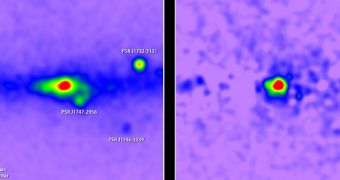A team of astrophysicists from the US Department of Energy's (DOE) Fermi National Accelerator Laboratory (Fermilab), the Harvard-Smithsonian Center for Astrophysics (CfA), the Massachusetts Institute of Technology (MIT) and the University of Chicago (UC) argue in a new study that dark matter at the core of the galaxy may be responsible for some peculiar gamma-ray emissions.
The group arrived at these conclusions after analyzing public science data collected by the NASA Fermi Gamma-ray Space Telescope. Scientists measured that amount of radiations released in this portion of the electromagnetic spectrum by known sources, and determined that a huge amount of gamma-rays come from origins that are not accounted for.
The excess emissions carry a signature that is consistent with theoretical predictions on some forms of dark matter, the investigators report in a recent issue of the esteemed journal Physical Review D.
Theories on the nature of dark matter – the form of matter believed to account for around 23 percent of the Universe's mass-energy budget – suggest that it exists in the highest concentrations at the cores of galaxies and galactic clusters. As such, it stands to reason that the central regions of the Milky Way should have more dark matter than its disk or outlying areas.
“The new maps allow us to analyze the excess and test whether more conventional explanations, such as the presence of undiscovered pulsars or cosmic-ray collisions on gas clouds, can account for it. The signal we find cannot be explained by currently proposed alternatives and is in close agreement with the predictions of very simple dark matter models,” comments Dan Hooper.
The expert, who was the lead author of the new paper, holds an appointment as an associate professor in astronomy and astrophysics at the University of Chicago, and is also an astrophysicist at Fermilab. Some of the most common gamma-ray sources at the galactic core include binary star systems, pulsars, supernova, and free-traveling, highly-charged particles that interact with gas clouds.
Astrophysicists say that Weakly-Interacting Massive Particles (WIMP), the stuff believed to make up dark matter, come in a variety of flavors. Since WIMP are their own antiparticles, when one particle meets another the two annihilate each other, leading to the production of gamma-rays. The Large Area Telescope (LAT) instrument on Fermi is sensitive to these wavelengths.
The new study allowed experts to conclude that WIMP may have a mass of 31 to 40 gigaelectronvolts (GeV). These values reflect the uniform distribution of resulting gamma-rays throughout the galactic core, as well as the consistent brightness recorded at these wavelengths.
“Dark matter in this mass range can be probed by direct detection and by the Large Hadron Collider (LHC), so if this is dark matter, we’re already learning about its interactions from the lack of detection so far,” says MIT theoretical physicist and study co-author, Tracy Slatyer.
“This is a very exciting signal, and while the case is not yet closed, in the future we might well look back and say this was where we saw dark matter annihilation for the first time,” the expert concludes.

 14 DAY TRIAL //
14 DAY TRIAL //